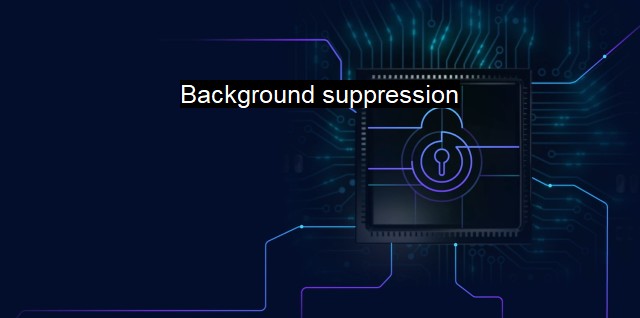What is Background suppression?
Background Suppression: Enhancing Cybersecurity through Accurate Antivirus Scanning and Threat Identification
Background suppression is a crucial facet of ongoing digital safety endeavors. This functionality coordinates the identification and reduction of information or procedures that unnecessarily consume system resources, or potentially put the system at risk of malicious infiltration.To understand the necessity of background suppression, a robust understanding of the workings of computer systems and viruses is critical. Every computer operation, be it booting up, running a program, carrying out an operation, invariably involves intense manipulation of data, bits, and bytes. These operations occur dynamically with thousands of background actions being continually amassed to provide the user-friendly interface that is typical of our computer interactions.
This flurry of action also provides an easy avenue for malicious codes, or viruses, to embed and hide within legitimate actions. This aspect is what makes antivirus software and cybersecurity suites vital elements for all computer-operated systems. One key component of these packages is the antivirus software's capability to maintain constant vigilance and suppression of unnecessary activities running in the background.
The primary function of background suppression within antivirus software is reducing or eliminating non-utilitarian processes from running on a system. Not every interaction that happens within a computer unit is necessary, beneficial, or safe. Background suppression combats malicious software by reducing system vulnerabilities and maximizing performance.
Generally, multiple streams of processes running simultaneously on a computer each claim their share of computing and memory resources. These streams, over time, can encumber and slow down the operations of a computer system considerably, particularly if malicious software is exploiting them. The implementation of background suppression lightens the load on the computer resources, improving speed, responsiveness, and overall system performance.
One technique often employed by background suppression to halt unwanted processes is heuristic analysis. With leveraging artificial intelligence algorithms, heuristic analysis aids in the prediction and tracking of suspicious or irregular activities that could potentially degrade the integrity of the system.
Background suppression not only optimizes the operation of the computer but also enhances the detection, prioritization, and proper management of legitimate threats. Some antivirus programs go further with behavior-based threat detection capabilities, establishing stricter control over what kind of backend processes can operate, particularly those that attempt to automate tasks or infiltrate the system stealthily.
Malware often depends on system vulnerabilities to infiltrate a system undetected. By implementing background suppression, the antivirus software ensures that these vulnerabilities are significantly reduced. This action in turn contributes to a more secure computing environment, making it harder for viruses or malicious software to exploit idle or unmonitored processes.
That said, background suppression plays a crucial role in an antivirus or cybersecurity suite. this feature is not alone in safeguarding the sovereignty of a system. It works in tandem with a host of other functionalities like virus scanning, threat blocking, intrusion detection, encryption, and multiple layers of protection to guard an entire technological spectrum from unwanted invasions.
Background suppression is a vital asset to any cybersecurity framework as a means to bolster computer performance, minimize system vulnerabilities, and markedly amplify system defenses. With significantly fewer processes operating in the background, security solutions are provided an optimized platform to efficiently scrutinize, expose, and address threatening software or irregular activities.
Despite the great advancements that have been made in the arena of background suppression and cybersecurity at large, the maintenance thereof, balanced by the evolving landscape of cyber threats, makes constant vigilance a necessity in the ever-ongoing battle against cyber-attacks.

Background suppression FAQs
What is background suppression in the context of cybersecurity and antivirus?
Background suppression is a function of some antivirus software that detects and blocks malware that is attempting to run in the background of a computer system. This feature is designed to prevent malware from running undetected while a user is performing other tasks on their computer.How does background suppression work in antivirus software?
Background suppression works by monitoring the system for any applications or processes that are running in the background without the user's knowledge or consent. If the software detects any suspicious activity, it will block the process and notify the user of the potential threat.Is background suppression a necessary feature in antivirus software?
Yes, background suppression is an important feature that can help prevent malware from infecting a computer system. Many types of malware are designed to run silently in the background, making them difficult to detect and remove. By using background suppression, users can protect their systems from these types of threats.Can background suppression cause any issues with legitimate software or programs?
In some cases, background suppression can cause issues with legitimate software or programs, particularly if they are designed to run in the background. Users may need to adjust their antivirus settings to allow certain programs to run without interference. It is important to have a good understanding of your antivirus software and its settings in order to effectively balance security and functionality.| | A | | | B | | | C | | | D | | | E | | | F | | | G | | | H | | | I | | | J | | | K | | | L | | | M | |
| | N | | | O | | | P | | | Q | | | R | | | S | | | T | | | U | | | V | | | W | | | X | | | Y | | | Z | |
| | 1 | | | 2 | | | 3 | | | 4 | | | 7 | | | 8 | | |||||||